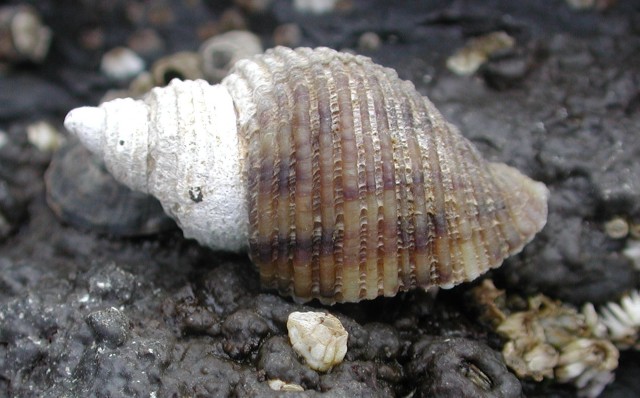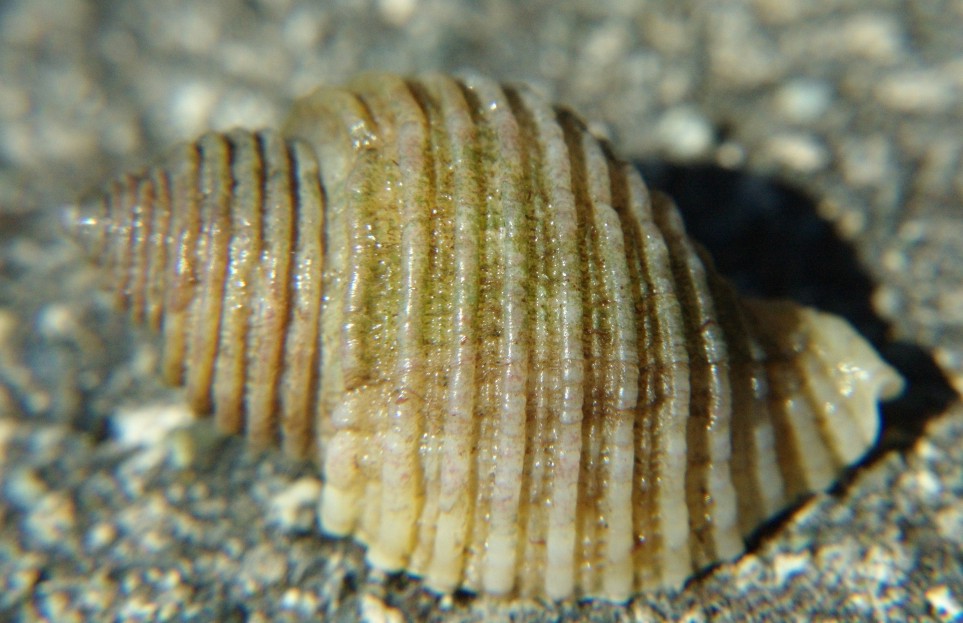Nucella canaliculata (Duclos, 1832)Common name(s): Channeled dogwinkle, Channeled purple |
|
| Synonyms: Thais canaliculata |  |
| Phylum
Mollusca
Class Gastropoda Order Neogastropoda Suborder Rachiglossa Family Nucellidae |
|
| Nucella canaliculata foraging on Swirl rocks. Total length about 2.5 cm. | |
| (Photo by: Dave Cowles July 2011) | |
Supplementary notes from Linda Schroeder for help in identifying this species: "N. canaliculata can be solid gray or white/yellow striped or white/orange striped. The ridges can be subtle or very prominent and can be variable spaced between different populations. They may be single large ridges with no smaller ones between, shorter ridges with smaller ridges between and sometimes there’s little distinction between the small and large ridges and they’re nearly equal with little to no spacing between them.."
How to Distinguish from Similar Species:Nucella ostrina has a thick shell and spiral ridges of 2 different sizes. Nucella lamellosa has only a few large spiral ridges on each whorl and may also have longitudinal ribs or frilly lamellae. Acanthina spirata has a large tooth on the outer lip of the aperture.
Geographical Range: Aleutian Islands to Cayucos, San Luis Obispo County, CA; uncommon north of Puget Sound or south of San Francisco Bay.
Depth Range: Middle intertidal.
Habitat: Rocky intertidal, often in or near mussel beds. On protected or exposed coasts. May be very abundant at some exposed sites on the Olympic Peninsula
Biology/Natural History: This species does not range as high in the intertidal as does N. ostrina, but higher than does N. lamellosa. Its main prey is Mytilus spp, and secondarily it feeds on barnacles such as Semibalanus cariosus. It drills shells by softening them with a secretion from the foot, then drilling through with the radula. It usually takes 1-2 days to drill and eat a prey individual. Breeding is in spring and summer. Females attach their eggs to rocks in flask-shaped capsules ("sea oats"), each of which may contain 15-55 eggs. Some of the eggs may be abortive and consumed by other larvae as they grow within the capsule. The young emerge from the capsule as benthic, juvenile snails about 1.3 mm in shell length.
In the study by Sorte and Hofmann (2005), thermotolerance of different Nucella species along the coast was found to be correlated with the latitude range and tidal height each species occupies. N. ostrina, which occurs higher in the intertidal than does N. canaliculata in Oregon and does not extend as far north, had higher heat tolerance than did N. canaliculata. N. emarginata, which extends the farthest south, and N. ostrina, which lives higher in the intertidal, recovered more quickly from thermal exposure than did N. canaliculata and N. lamellosa, which live lower in the intertidal, and N. lima, which has a more northern range. These differences in heat tolerance may be related to HSP70 molecular chaperones.
The famous purple dye from the city of Tyre, that colored royal Roman robes, was made from a relative of Nucella. The snails were ground up in a stone mortar; different combinations made different shades of purple. The dye should be fixed with lemon juice as a mordant. The American species produce a much less brilliant purple than do the Mediterranean species.
| Return to: | |||
| Main Page | Alphabetic Index | Systematic Index | Glossary |
References:
Dichotomous Keys:Flora and Fairbanks, 1966 (as Thais canaliculata)
Kozloff 1987, 1996
Smith and Carlton, 1975
General References:
Harbo,
1997
Harbo,
1999
Johnson
and Snook, 1955
Kozloff,
1993
Morris,
1966
Morris
et al., 1980
O'Clair
and O'Clair, 1998
Ricketts
et al., 1985
Sept,
1999
Scientific
Articles:
Rawlings, 1999. Adaptations to physical stresses in the intertidal zone: the egg capsules of neogastropod molluscs. American Zoologist 39:2 pp. 230-243
Sorte,
Cascade J.B. and Gretchen E. Hofmann, 2005.
Thermotolerance and
heat-shock protein expression in northeastern Pacific Nucella
species
with different biogeographical ranges. Marine Biology 146:
985-993
Wootton, J. Timothy, 2002. Mechanisms of successional dynamics: consumers and the rise and fall of species dominance. Ecological Research 17 pp. 249-260
Web sites:
General Notes and Observations: Locations, abundances, unusual behaviors:
In my experience, this species is far less common around Rosario than is Nucella lamellosa (most common) or Nucella emarginata.

A small N. canaliculata. This individual seems to be covered by small byssal threads. Photo by Dave Cowles, July 2005
This Nucella canaliculata could easily key to N. ostrina because of the clear alternation of large and small spiral ridges. However, the deep grooves between the largest ridges indicate that it is N. canaliculata. My thanks to Linda Schroeder for help in identifying this specimen. Photo by Dave Cowles, August 2011Authors and Editors of Page:
Dave Cowles (2005): Created original page
